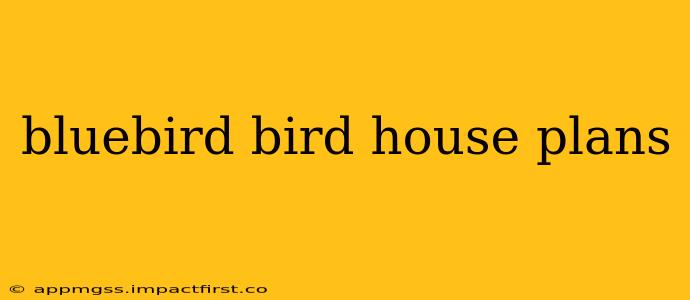Bluebirds, with their vibrant plumage and cheerful songs, are a welcome sight in any garden. Attracting these beautiful birds to your property can be as simple as providing a suitable nesting habitat. This guide will walk you through creating your own bluebird birdhouse, complete with plans and helpful tips to ensure its success. Building a birdhouse is a rewarding project that connects you with nature, and the joy of watching bluebirds raise their young is priceless.
What Size Should a Bluebird Birdhouse Be?
One of the most crucial aspects of building a successful bluebird birdhouse is getting the dimensions right. Bluebirds prefer a snug, secure space. Too large, and the house becomes vulnerable to predators like snakes or larger birds. Too small, and the birds won't find it comfortable. The ideal dimensions are generally:
- Floor: 4 x 4 inches (10 x 10 cm)
- Entrance Hole: 1 ½ inches in diameter (3.8 cm) – this size is crucial to deter larger birds while allowing bluebirds easy access.
- Height: 8 inches (20 cm) (excluding the roof)
What Kind of Wood is Best for a Bluebird Birdhouse?
Choosing the right wood is important for durability and longevity. Untreated, natural wood is best to avoid harming the birds. Excellent options include:
- Cedar: Naturally resistant to rot and insects, cedar offers excellent protection for your birdhouse.
- Pine: Readily available and relatively inexpensive, pine is a good choice if properly treated with a non-toxic sealant.
- Untreated Redwood: Similar to cedar in its natural resistance to rot and decay.
Avoid using treated lumber, as the chemicals can be harmful to birds.
Where Should I Place a Bluebird Birdhouse?
Placement is key to attracting bluebirds and ensuring their safety. Consider these factors:
- Height: Mount the birdhouse 4-6 feet above the ground. This helps protect the nest from ground predators.
- Location: Place it in a sunny, open area with a clear flight path. Avoid overhanging branches that could provide cover for predators.
- Protection from the elements: Ensure the birdhouse is sheltered from strong winds and heavy rain.
- Proximity to food and water sources: Bluebirds need easy access to food and water, so placing the birdhouse near natural food sources or a birdbath can increase its attractiveness.
How Do I Clean a Bluebird Birdhouse?
Cleaning your bluebird birdhouse is essential to prevent the build-up of parasites and diseases. This should be done after each breeding season, ideally in the late fall or early winter. Gently remove old nesting material and droppings, using a stiff brush or a vacuum cleaner with a soft brush attachment. Avoid using harsh chemicals.
What are the Best Materials for Building a Bluebird Birdhouse?
Besides the wood itself, you'll need:
- Screws or Nails: Use exterior-grade screws or galvanized nails.
- Saw: A hand saw or circular saw will work.
- Drill: For pilot holes (to prevent wood splitting) and to make the entrance hole.
- Sandpaper: For smoothing the wood.
- Wood glue (optional): For added strength.
Can I Paint a Bluebird Birdhouse?
While not necessary, you can paint the birdhouse with exterior-quality non-toxic paint. Choose muted colors that blend with the natural environment to avoid attracting unwanted attention.
What are some common mistakes to avoid when building a bluebird birdhouse?
- Using treated lumber: The chemicals can be harmful to birds.
- Making the entrance hole too large: This can attract larger birds that might prey on the bluebirds.
- Poor placement: Incorrect placement can leave the birdhouse vulnerable to predators or the elements.
- Forgetting drainage: Ensure your design allows for proper ventilation and drainage to prevent rot and mold.
By following these plans and tips, you can create a welcoming home for bluebirds and enjoy the beauty and wonder they bring to your yard. Remember, building a birdhouse is a labor of love; take your time, and enjoy the process!
